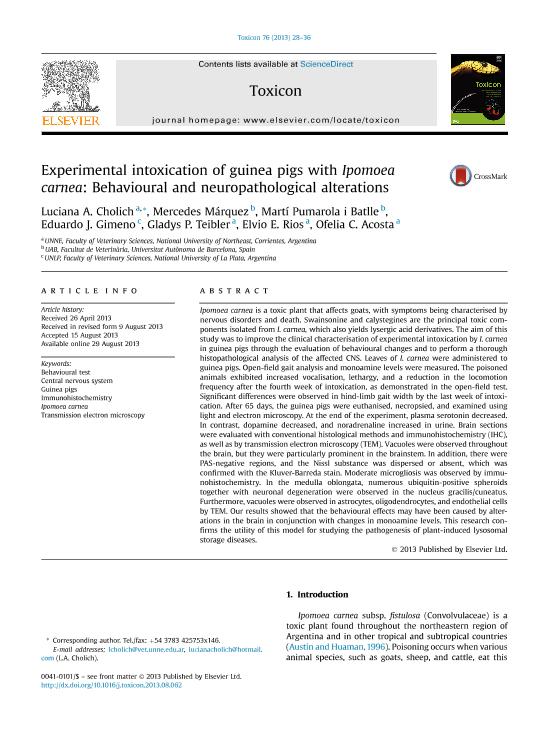Artículo
Experimental intoxication of guinea pigs with Ipomoea carnea: Behavioural and neuropathological alterations
Cholich, Luciana Andrea ; Marquez, Mercedes; Pumarola i Batlle, Martí; Gimeno, Eduardo Juan
; Marquez, Mercedes; Pumarola i Batlle, Martí; Gimeno, Eduardo Juan ; Teibler, Gladys Pamela; Rios, Elvio E.; Acosta, Ofelia Cristina
; Teibler, Gladys Pamela; Rios, Elvio E.; Acosta, Ofelia Cristina
 ; Marquez, Mercedes; Pumarola i Batlle, Martí; Gimeno, Eduardo Juan
; Marquez, Mercedes; Pumarola i Batlle, Martí; Gimeno, Eduardo Juan ; Teibler, Gladys Pamela; Rios, Elvio E.; Acosta, Ofelia Cristina
; Teibler, Gladys Pamela; Rios, Elvio E.; Acosta, Ofelia Cristina
Fecha de publicación:
29/08/2013
Editorial:
Elsevier Academic Press Inc
Revista:
Toxicon
ISSN:
0041-0101
e-ISSN:
1879-3150
Idioma:
Inglés
Tipo de recurso:
Artículo publicado
Resumen
Ipomoea carnea is a toxic plant that affects goats, with symptoms being characterised by nervous disorders and death. Swainsonine and calystegines are the principal toxic components isolated from I. carnea, which also yields lysergic acid derivatives. The aim of this study was to improve the clinical characterisation of experimental intoxication by I. carnea in guinea pigs through the evaluation of behavioural changes and to perform a thorough histopathological analysis of the affected CNS. Leaves of I. carnea were administered to guinea pigs. Open-field gait analysis and monoamine levels were measured. The poisoned animals exhibited increased vocalisation, lethargy, and a reduction in the locomotion frequency after the fourth week of intoxication, as demonstrated in the open-field test. Significant differences were observed in hind-limb gait width by the last week of intoxication. After 65 days, the guinea pigs were euthanised, necropsied, and examined using light and electron microscopy. At the end of the experiment, plasma serotonin decreased. In contrast, dopamine decreased, and noradrenaline increased in urine. Brain sections were evaluated with conventional histological methods and immunohistochemistry (IHC), as well as by transmission electron microscopy (TEM). Vacuoles were observed throughout the brain, but they were particularly prominent in the brainstem. In addition, there were PAS-negative regions, and the Nissl substance was dispersed or absent, which was confirmed with the Kluver-Barreda stain. Moderate microgliosis was observed by immunohistochemistry. In the medulla oblongata, numerous ubiquitin-positive spheroids together with neuronal degeneration were observed in the nucleus gracilis/cuneatus. Furthermore, vacuoles were observed in astrocytes, oligodendrocytes, and endothelial cells by TEM. Our results showed that the behavioural effects may have been caused by alterations in the brain in conjunction with changes in monoamine levels. This research confirms the utility of this model for studying the pathogenesis of plant-induced lysosomal storage diseases.
Archivos asociados
Licencia
Identificadores
Colecciones
Articulos(CCT - NORDESTE)
Articulos de CTRO.CIENTIFICO TECNOL.CONICET - NORDESTE
Articulos de CTRO.CIENTIFICO TECNOL.CONICET - NORDESTE
Citación
Cholich, Luciana Andrea; Marquez, Mercedes; Pumarola i Batlle, Martí; Gimeno, Eduardo Juan; Teibler, Gladys Pamela; et al.; Experimental intoxication of guinea pigs with Ipomoea carnea: Behavioural and neuropathological alterations; Elsevier Academic Press Inc; Toxicon; 76; 29-8-2013; 28-36
Compartir
Altmétricas



